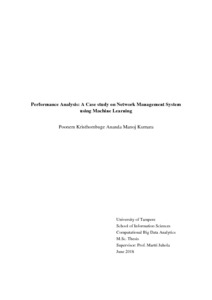Performance analysis : a case study on network management system using machine learning
Poonem Kristhombuge, Ananda Manoj Kumara (2018)
Poonem Kristhombuge, Ananda Manoj Kumara
2018
Tietojenkäsittelytieteiden tutkinto-ohjelma - Degree Programme in Computer Sciences
Luonnontieteiden tiedekunta - Faculty of Natural Sciences
This publication is copyrighted. You may download, display and print it for Your own personal use. Commercial use is prohibited.
Hyväksymispäivämäärä
2018-07-02
Julkaisun pysyvä osoite on
https://urn.fi/URN:NBN:fi:uta-201807092291
https://urn.fi/URN:NBN:fi:uta-201807092291
Tiivistelmä
Businesses have legacy distributed software systems which are out of traditional data analysis methods due to their complexities. In addition, the software systems evolve and become complex to understand even with the knowledge of system architecture. Machine learning and big data analytic techniques are widely used in many technical domains to get insight from this large business data due to performance and accuracy. This study was conducted to investigate the applicability of machine learning techniques on performance utilization modelling on Nokia’s network management system. The objective was to study and develop resource utilization models based on system performance data and to study future business needs on capacity analysis of the software performance to minimize manual tasks.
The performance data was extracted from network management system software which contains resource usages on system level and component level measurements based on input load. In general, the simulated load on a network management system is uniform with less variance. To overcome this during the research, different load profiles were simulated on the system to assess its performance. Later the data was processed and evaluated using set of machine learning techniques (linear regression, MARS, K-NN, random forest, SVR and feed forward neural networks) to construct resource utilization models. Further, the goodness of developed models was evaluated on simulated test and customer data.
Overall, no single algorithm performed best on all resource entities, but neural networks performed well on most response variables as a multivariable output model. However, when comparing performance across customer and test datasets, there were some differences which were also studied. Overall, the results show the feasibility on modeling system resource that can be used in capacity analysis. In future iterations, further analysis on remaining system nodes and suggestions have been made in the report.
The performance data was extracted from network management system software which contains resource usages on system level and component level measurements based on input load. In general, the simulated load on a network management system is uniform with less variance. To overcome this during the research, different load profiles were simulated on the system to assess its performance. Later the data was processed and evaluated using set of machine learning techniques (linear regression, MARS, K-NN, random forest, SVR and feed forward neural networks) to construct resource utilization models. Further, the goodness of developed models was evaluated on simulated test and customer data.
Overall, no single algorithm performed best on all resource entities, but neural networks performed well on most response variables as a multivariable output model. However, when comparing performance across customer and test datasets, there were some differences which were also studied. Overall, the results show the feasibility on modeling system resource that can be used in capacity analysis. In future iterations, further analysis on remaining system nodes and suggestions have been made in the report.
